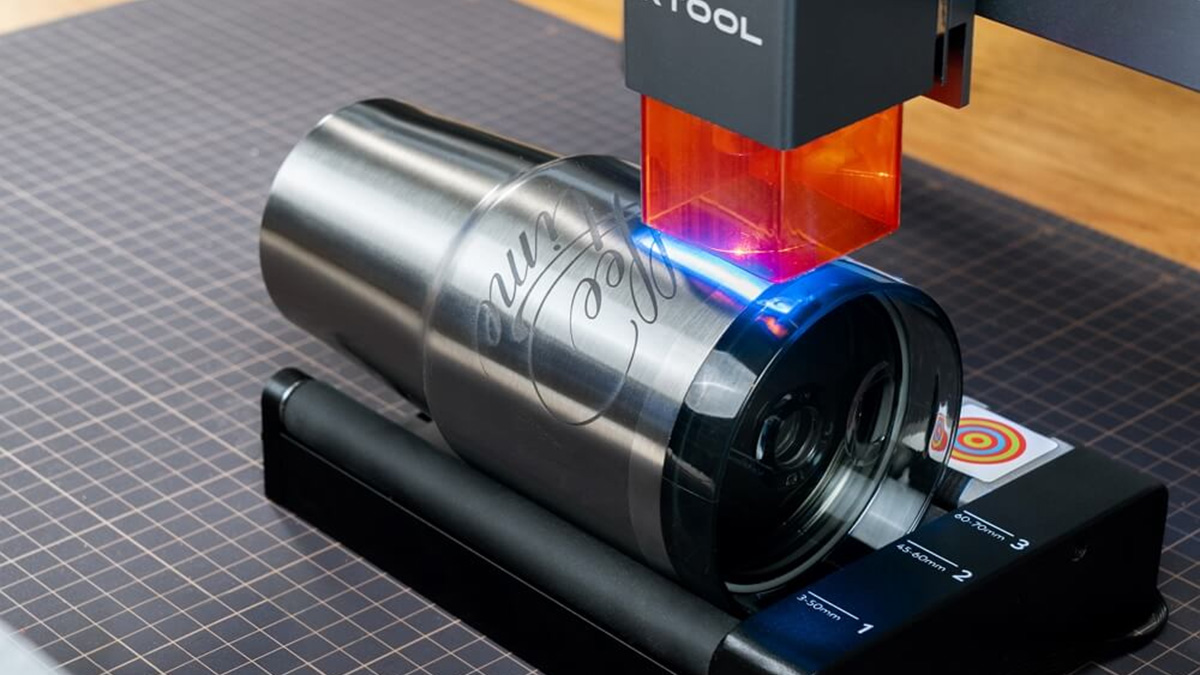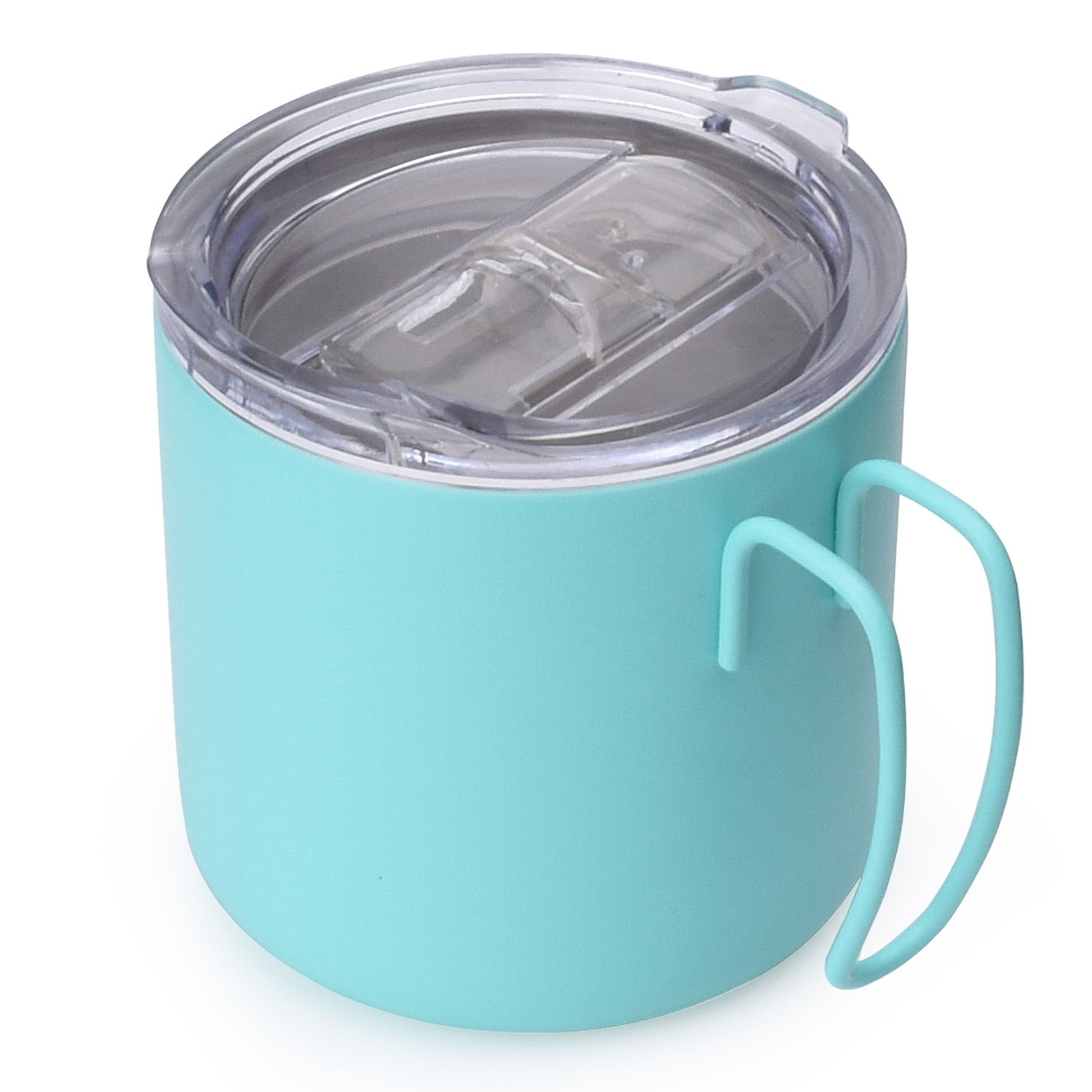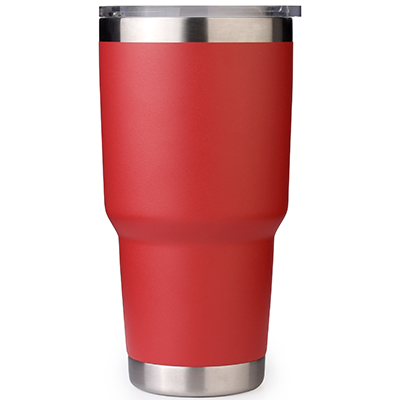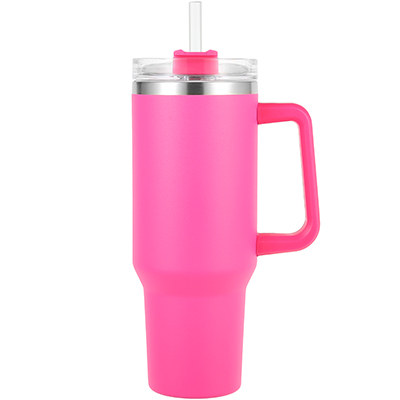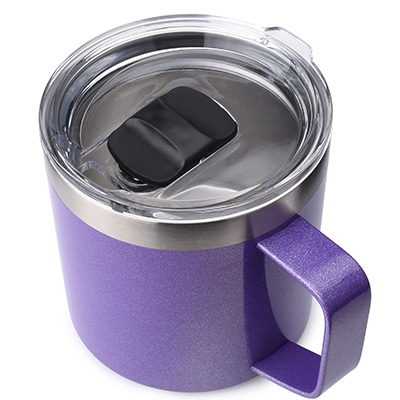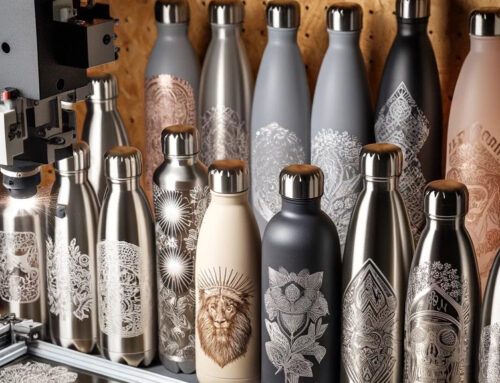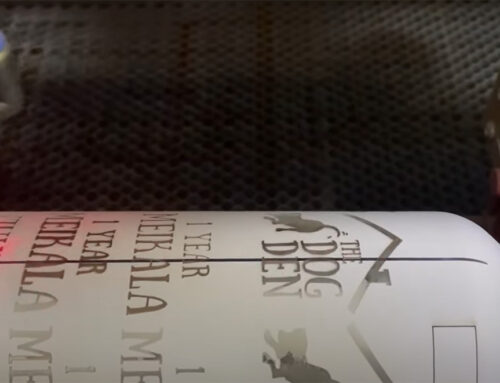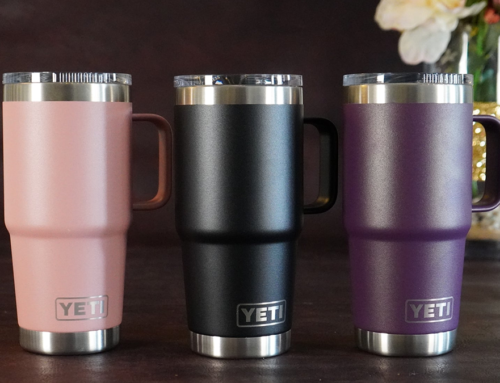Contents
- 1. What is laser engraving?
- 2. When was laser engraving invented?
- 3. How does laser engraving work?
- 4. What materials can be used for laser engraving?
- 5. What are the pros and cons of laser engraving?
- 6. What are the classifications of laser engraving machines?
- 7. Which laser engraving machine is best for stainless steel water bottles?
- 8. Conclusion
1. What is laser engraving?
Laser engraving is a commonly used laser marking technique widely applied in product identification and traceability fields. This technology allows for the creation of permanent markings on various types of materials, offering high precision and contrast. The working principle of laser engraving involves using a laser beam to focus on specific areas of the material’s surface. The laser beam’s energy is highly concentrated, leading to localized heating and vaporization or evaporation of the material upon interaction. This process results in the engraving of textures or patterns on the material’s surface, forming permanent marks.
Laser engraving technology boasts exceptional precision, enabling the creation of intricate and fine patterns such as text, images, and barcodes. Due to the high energy density of the laser beam, it can process materials of varying hardness and complexity, including metals, plastics, glass, ceramics, and more. The resulting marks exhibit high contrast, meaning there is a significant difference in brightness between the marked and unmarked areas, making the identification easy to read and recognize. This is of great significance in product traceability, anti-counterfeiting measures, branding, and promotional activities.
2. When was laser engraving invented?
This process is suitable for marking logos, bar-codes, serial numbers, and QR codes on parts. It forms a set of highly reliable processes for traceability, identification, product decoration, and other applications, alongside laser etching, annealing, ablating, and other laser marking techniques. The history of laser engraving is closely connected with manual engraving. Manual engraving involves using sharp objects (engraving tools) to mark parts. For instance, about 5 million years ago, stones served as engraving tools. Currently, the oldest manually engraved parts can be traced back to approximately 5 million years ago. Over the years, manual engraving has evolved due to technological advancements.
The beginning of laser engraving as a process can be traced back to Albert Einstein’s concept of LASER in 1916 and its optimization in the 1950s. Theodore Maiman created the first optical laser, and Gordon Gould was recognized for inventing the initial laser light. When Western Electrics manufactured the first laser machine in 1965, lasers became a crucial component for drilling. However, it was not until 1967, with the advent of CO2 lasers, that lasers were truly used for engraving. Further technological advancements led to the development of other types of laser machines suitable for engraving, such as UV and MOPA laser engravers.
3. How does laser engraving work?
Laser engraving is a process that involves focusing a laser beam at an appropriate power level onto a specific part from a controlled distance. This focused laser energy interacts with the material, causing it to evaporate and create a permanent mark on the surface. Achieving the desired outcome depends on the careful adjustment of the power level. Insufficient power may result in an ineffective engraving, while excessive power can lead to burning or damaging the material. Despite the need for precise power control, the laser engraving process is generally considered straightforward. By selecting the right settings and ensuring the proper alignment of the laser, one can produce accurate and high-quality engravings on various materials with relative ease. Here are the steps required for laser engraving part:
- Brainstorming for ideas: This involves coming up with the creative concepts for the appearance of the mark and the right material for the job. It requires a high level of creativity and is, therefore, the most critical step in the laser engraving process as it determines the quality and efficiency of the mark. Ideas are very essential because laser engraving marks are permanent. Thus, after laser engraving process is completed, it’s not easy to change erroneous marks.
- Design the identification image: Design the image to be marked on a computer program. You can use software like Adobe Illustrator, Inkscape, LightBurn, DraftSight or other vector graphic design tools. Additionally, you need to ensure that the machine is compatible with the design life.
- Material selection: Select a material that is both compatible with the laser engraving machine and complements your design. Laser engraving machines have the capability to work with various materials, including stone, glass, plastic, and metal. However, each material type has its own specific list of suitable options. For instance, plastics are well-suited for UV laser engraving machines since they operate as cold lasers, producing minimal heat. On the other hand, organic materials find better compatibility with CO2 laser engraving machines.
- Machine setup: The machine’s setup and type will vary depending on the process. Set the laser intensity, cutting depth, speed, number of passes and line width and test similar materials to see the effects. Store the settings that reflect the desired outcome.
- Laser engrave the part: Place the material into the machine and proceed with the marking. You can remove the material from the machine and clean it at the marked area.
4. What materials can be used for laser engraving?
The laser engraving process is compatible with many materials and here are some common in the market:
- Plastic: Acrylic and POM (Polyoxymethylene) are common materials used in laser engraving. However, the laser power must be adequately adjusted and calibrated based on the material’s absorption spectrum and other additives present. Plastic is more compatible with CO2 and UV laser engraving machines.
- Metal products: Metal is one of the most common materials used in laser engraving, making it “the heart of industries”. Metals such as stainless steel, gold, silver, iron and aluminum are compatible with this process. Fiber laser engraving machines are most suitable for marking on metal.
- Wood: Wood is also compatible with laser engraving. Although high temperatures can potentially cause wood to catch fire, you can adjust the laser engraving machine’s power to carve wood without causing any fires. Plywood, medium-density fiberboard(MDF), and hardboard are popular wood materials for laser engraving.
- Coated metals: The laser engraving process is also applicable to coated metals, allowing for vaporization of the coating and clean removal.
5. What are the pros and cons of laser engraving?
Laser engraving has gained high recognition within the industry due to its advantages, such as fast production speed, high precision and compatibility with various materials. However, this process also has its drawbacks. Here are some advantages and disadvantages you should be aware of:
Advantages
- Fast production process: Laser engraving is a rapid process that typically take 3-5 minutes, depending on the material, design, and laser power. Its speed is crucial in rapid manufacturing.
- Wide range of materials: Laser engraving is compatible with many materials, including metals, wood, plastics, providing customers with greater freedom in material and design choices compared to dot peen and chemical etching marking systems.
- Platform precision: Laser engraving machines offer high precision and accuracy, capable of engraving within +/- .01.This high precision makes it suitable for industries like jewelry, medical and electronics.
- Reproducibility: Laser marking machines are suitable for batch marking processes due to their reproducibility. The machine’s software stores designs, allowing the same marks to be applied to different or identical parts. Reproducibility ensures faster turnaround time and aesthetically pleasing products.
- Marking durability: Laser engraved markings have high contrast, improving visibility, and they are permanent. This durability makes them resistant to various environmental conditions, such as wear, high temperatures, or chemicals. Unlike inkjet marking, where the marking chemicals can be washed off in non-conductive environments, laser engraving markings are long-lasting and suitable for product identification and traceability.
- Environmentally friendly production process: Laser engraving does not require consumables like chemicals that can pollute the environment, as seen in inkjet marking. Additionally, unlike dot peen machines, they do not generate any noise. Therefore, the process is environmentally friendly, clean, and energy-efficient.
- Non-contact marking: As a non-contact marking process, laser engraving eliminates material contamination and physical and mechanical deformation of components. This is unlike dot peen and inkjet marking, where the chemicals used may be incompatible with the material.
Disadvantages
- Requirement for specialized knowledge: Operating a laser engraving machine requires skilled operators to fully utilize the machine’s potential and deliver high-quality markings. The high demand for specialized knowledge increases operational costs, and the quality of markings depends on the operator’s expertise.
- High maintenance costs: Laser engraving machines are expensive compared to other marking systems. Their maintenance and operational costs are also high. This indicates that using one will require initial and ongoing investments. Due to the high operational and maintenance costs, outsourcing to laser engraving services is recommended.
- Hazardous fumes: During the marking process, the machine emits hazardous gases and fumes. Thus, you need good ventilation and protective systems to ensure a safe working environment.
Metal Tumbler 20 oz
$2.15-$3.16
Insulated Tumbler 30 oz
$2.59-$3.90
Quencher Tumbler 40 oz
$3.35-$3.99
Insulated Rambler Mug 14 oz
$5.51-$6.31
6. What are the classifications of laser engraving machines?
Laser engraving machines are versatile tools used for etching, engraving, and marking various materials with precision and speed. The types of laser engraving machines can be broadly categorized based on the laser source they use.
Classified by laser source
- CO2 laser engraving machine
- Semiconductor laser engraving machine
- YAG laser engraving machine
- Fiber laser engraving machine
Classified by laser visibility
- UV laser engraving machine (Invisible)
- Green laser engraving machine (Invisible laser)
- Infrared laser engraving machine (Visible laser)
Classified by laser wavelength
- 532nm laser engraving machine
- 808nm laser engraving machine
- 1064nm laser engraving machine
- 64um laser engraving machine
- 266nm laser engraving machine
Among them, the most widely used for stainless steel water bottles is the 1064nm laser.
7. What laser engraving machine is best for stainless steel water bottles?
Before introducing which laser engraving machine is most suitable for stainless steel water bottles, let’s look at three common laser engraving machines well as their characteristics and applications:
- Semiconductor laser engraving machine: It uses a semiconductor array as the light source, resulting in a high optical conversion efficiency of over 40%. It has low thermal loss and does not require a separate cooling system. It consumes less power, around 1800W/H. The overall performance is very stable, belonging to a maintenance-free product with a maintenance-free time of up to 15,000 hours, equivalent to 10 years of maintenance without the need for krypton lamp replacement or consumables. It has excellent application characteristics in metal processing and is also suitable for various non-metal materials such as ABS, nylon, PES, PVC, etc. It is more suitable for applications that require finer and higher precision. Commonly used in industries such as electronic components, plastic buttons, integrated circuits (IC), electrical appliances, and mobile communications.
- CO2 laser engraving machine: This machine utilizes a CO2 metal (RF) laser, equipped with a beam expander focusing optical system and a high-speed galvanometer scanner. It boasts stable performance, a long operational lifespan, and requires no regular maintenance. Its laser beam is generated by discharging CO2 gas mixed with auxiliary gases in a discharge tube under high voltage. Once focused and scanned through the galvanometer, it becomes suitable for various laser processing tasks. This particular machine finds wide applications in multiple industries, including crafts, gifts, furniture manufacturing, leather clothing production, advertising signs creation, model making, food packaging, electronic components processing, pharmaceutical packaging, printing plate production, and shell nameplate fabrication, among others.
- Fiber laser engraving machine: It uses a fiber laser to output laser, and then achieves engraving function through an ultra-high-speed scanning galvanometer system. The fiber laser engraving machine has high electro-optical conversion efficiency, uses air cooling, has a compact size, good beam quality, high reliability, and an extended operational lifespan. It is energy-efficient and can engrave both metal and some non-metal materials. It is mainly applied in fields that require high depth, smoothness, and precision, such as stainless steel decorations on water bottles. It is capable of engraving bitmap images on metal, plastic, and other surfaces, and the engraving speed is 3 to 12 times faster than traditional first-generation lamp-pumped laser engraving machines and second-generation semiconductor laser engraving machines.
- UV laser engraving machines: UV lasers emit ultraviolet light and are ideal for marking and engraving sensitive materials or those that absorb UV radiation. They can engrave on materials like glass, plastics, and metals. UV lasers are commonly used in the electronics and medical device industries due to their ability to mark delicate components.
Among the above laser engraving machines, UV and fiber ones are most suitable for engraving on the stainless steel water bottles. When choosing between a UV laser engraving machine and a fiber laser engraving machine for stainless steel water bottles, consider your specific requirements. If you need detailed and high-resolution engravings for aesthetics, a UV laser engraving machine with its shorter wavelength (around 355 nm) is ideal. On the other hand, if you require deeper and faster engravings for serial numbers or barcodes in a high-volume production environment, a fiber laser engraving machine with its longer wavelength (around 1064 nm) and greater power would be more suitable. Both options provide permanent and resistant marks on stainless steel, but the choice depends on the level of detail needed and the production volume you expect.
8. Conclusion
Laser engraving is a versatile and widely used technology for creating permanent markings on various materials, including stainless steel. Consider factors such as the level of detail needed, production volume, and budget when selecting the best laser engraving machine for stainless steel water bottles. Regardless of the choice, laser engraving ensures durable, high-contrast, and aesthetically pleasing marks that enhance product identification, branding, and traceability.
Besides, you should be aware that good blank stainless steel water bottles are the foundation of laser engraving if you want to sell delicate,high-quality and high-performance products to your customers. We, KingStar, are an OEM / ODM food container manufacturer factory. We provide one-stop custom manufacturing service from product concept, research and development, tooling fabrication, 3D prototype building, mass production, quality control and globally shipping. Our engineering team will handle all the technical works for you. If you are going to start up a vacuum insulated food container / lunch box / water bottle / insulated coffee cup / flask / jug / tumbler / growler business, we will be your great partner to help you. For more information, please contact us!

